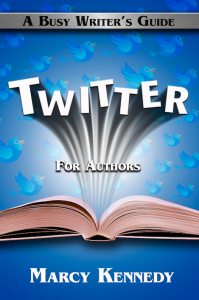
Note from Jane: Today’s guest post is by Marcy Kennedy (@MarcyKennedy).
Almost as soon as authors were told they should be on social media to build their platform, a counter-contingent of people started talking about how social media was a waste of time. They’d tell stories of using Twitter or Facebook or whatever the flavor of the month was and how they didn’t see any increase in sales or growth in their readership.
Usually there’s a simple reason for why social media didn’t work for them—they were doing it wrong.
I hope to save you some time and heartache by explaining seven of the biggest mistakes I see authors making on Twitter. When we use Twitter correctly, it’s still one of the best possible tools for expanding our reach.
Mistake #1: Using your bio as a sales pitch for your book.
Have you ever come across a Twitter bio that looks like this?
Author of 5-star #fantasy novel SKY DIAMOND available for #Kindle and #Nook. Passionate about #football, #dogs, and #running.
This bio scares followers away for a couple of reasons.
Adding hashtags into our bio makes it annoying for humans to read, and it suggests we’re going to spam them to buy our book as soon as they follow us.
Telling people how many stars our book has on Amazon, or saying it’s the best thing since The Hunger Games comes across as arrogant. People don’t buy books based on a Twitter bio. They buy based on interest in the subject matter or because they know and like the author.
Your bio should be about you. What do you write? How are you unique? What type of things will you regularly be tweeting about? That type of info makes people interested in following you and getting to know you.
Mistake #2: Automating everything.
Authors often set up a direct message to automatically go out to everyone who follows them, asking new followers to check out their book, visit their website, or like their Facebook page. Automating a direct message in this way is a bad idea. You immediately come off as a marketing bot rather than a real person.
Another automation trap is scheduling all tweets and never spending time on Twitter. I’m not against the occasional scheduled tweet, but be careful about it.
Here’s the crux of the matter: Scheduling tweets shouldn’t be used in place of actually being on Twitter and interacting. If we’re not there, we’re asking people to do something we’re not willing to do. We want to take from them, but we don’t want to give. What if everyone scheduled tweets but never spent time on Twitter? Who would see all those scheduled tweets?
Automating tweets can also lead to awkward situations. If everyone on Twitter is talking about a recent tragedy, and our Twitter account is spitting out self-promotion, it paints an unflattering picture.
A little authentic time on Twitter is better than a constant stream of automated messages.
Mistake #3: Protecting your tweets.
The point of social media is to be accessible. If we protect our tweets, we’re going to lose a lot of potential followers. Most people won’t go through the extra step of asking for permission to follow us. No one wants to take the risk of being rejected.
Mistake #4: Forgetting to have Twitter notify you when someone interacts with you.
Part of the challenge we all face with all social media is how to manage our time. So I make sure Twitter tells me when my tweets are marked as favorites, when I’m retweeted, when my tweets get a reply or I’m mentioned, when I’m followed by someone new, and when I’m sent a direct message.
By having notifications sent directly to my email inbox, I’m more able to be interactive without having to keep Twitter (or TweetDeck or Hootsuite) open all day. Plus, I miss fewer people who are trying to connect with me and the content I’m producing.
Mistake #5: Only tweeting about your book or your blog posts.
This is like being that person at the party who only wants to talk about themselves. Or who keeps trying to sell something (like the chocolate from their child’s school fundraiser). Everyone avoids those people. It’s the same on social media.
Our time on Twitter should be half conversation (building relationships), about 25% reciprocation (tweeting other people’s material), and 25% promotion of our books and blog posts. When we spend our time this way, the people we’ve built relationships with through conversation and reciprocation will retweet our tweets, amplifying our reach.
Mistake #6: Not using hashtags (or using them wrong).
Many people follow interesting hashtags by creating a column/stream for them. When we put a hashtag at the end of our tweets, that tweet is now seen by everyone who’s watching that hashtag, not just the people who follow us. Properly used, hashtags can expand our audience exponentially because we reach people who wouldn’t have known about us otherwise.
But here’s the catch. We can’t just slap a # sign in front of any old word and expect results. Not every potential hashtag is actively used and watched. We have to find ones that are. If we use abandoned hashtags, we might as well have not included a hashtag at all.
Make sure a hashtag is being used regularly either by researching it yourself (run a search through Twitter and see what comes up) or using a site like Hashtags.org.
Mistake #7: Not creating lists.
A Twitter list can be added to a column in TweetDeck or Hootsuite so that we’re able to watch the tweets from specific accounts that we’ve curated or selected (or that someone else has gathered). Twitter lists can help us make connections with agents, editors, or book reviewers; build relationships with other writers in our genre; keep track of subject matter experts; connect with writers who live in our area; reciprocate for people who regularly retweet our tweets; and stay in touch with fans who contact us about our books or say something good about our writing. Lists are an organizational and time management life saver.
Your turn: How do you feel about Twitter? What’s your biggest struggle?
 Note from Jane: If you found this post helpful, then check out Twitter for Authors: A Busy Writer’s Guide by Marcy Kennedy, available in ebook and print.
Note from Jane: If you found this post helpful, then check out Twitter for Authors: A Busy Writer’s Guide by Marcy Kennedy, available in ebook and print.
Marcy Kennedy is a suspense and speculative fiction writer who believes fantasy is more real than you think. Alongside her own writing, Marcy works as a freelance fiction editor and teaches classes on craft and social media. She’s also the author of the bestselling Busy Writer’s Guides series of books. You can find her blogging about writing and about the place where real life meets science fiction, fantasy, and myth at MarcyKennedy.com.

Well this has motivated me to give Twitter another try! Right now I’m pretty much just a watcher. I read tweets and links, but I never tweet anything myself, mostly because I don’t know what to say. And I do not get how to use hashtags at all. Honestly, I find them distracting and I prefer to read tweets without them, so I haven’t tried using them myself. I feel like I have some more learning and research to do in a couple of areas before I can attempt to really be on Twitter. But now I am ready to do that research. 🙂
Hashtags can be very distracting because a lot of people use them wrong. They should really be at the end of the tweet where they’re not going to make people stumble. As for what you should be tweeting about, that depends on what your ideal readers would be most interested in and where that overlaps with your own interests 🙂
Thank you for saying that about the automated response. That’s my biggest pet peeve. I get why people think it’s a personal touch, but it still comes off as calculated. I recently had a person thank me for the follow then suggest I follow them on Facebook too – which I already was. *head desk* Great post, as usual.
It’s one of my biggest pet peeves too. The worst is when they automate a message that won’t even be relevant for everyone who follows them such as “What are you writing?”
Whenever someone expresses confusion over how to use Twitter, I always ask if they use lists. They never are. Lists are what make Twitter functional. Otherwise it’s an overwhelming avalanche of information. I also regularly change my lists if someone tweets too much or isn’t tweeting something that’s relevant.
I really started to enjoy Twitter once I figured out lists. Before that, I was overwhelmed by the process of trying to sort out what to pay attention to and how to spread out my social media time. Twitter on its own is unwieldy, but once you start using a program that allows lists it solves the problem.
[…] Chuckumentary / via Flickr Note from Jane: Today’s guest post is by Marcy Kennedy (@MarcyKennedy). […]
Great post, Marcy.
I really like Twitter. I’ve met a number of nice folks there. I find lots of interesting and funny things that I like to retweet. One mistake people make is using all 140 characters. With a tweet that stops at 120 characters or so, there’s room to retweet.
Very true. That’s a tip everyone should try to follow. Thanks for sharing!
Thanks for this information. I’ve tried to get better at Twitter but I didn’t know about lists. I have found hashtags to be incredibly beneficial. I can tweet about a story to download, check my analytics, and see where the story downloads have spiked. So I know it works. Now off to learn about lists!
I think you’ll love how much easier they make keeping up with things on Twitter 🙂
Well, I know I already like you because of your spectacular name. The post was hugely helpful to me because I’m not on Twitter yet. Frankly, I’m afraid of the time suck it will be. However, if I do became a Tweeter, I now know what NOT to do. Thanks.
I use Twitter more than Facebook for my writing persona. Glad to see that I haven’t (unwittingly) committed any of the mistakes you mention! I use Tweetdeck and have added hashtag columns and my notification column so I can keep track of everyone who follows me, favorites a tweet of mine and retweets. Also, if you want to be a part of a hashtag discussion, you can use Tweepi. It will automatically add the hashtag for you so you can just converse. Aside from Twitter searches, I can find popular hashtags by clicking on the ones I see used most often by people I follow.
All really good points you make. I’ve found some good connections in twitter, but you really do need to check your notifications, and respond!! Without lists it’s a lost cause, and even with them it’s hard to keep up. But I also agree that there’s nothing worse than a writer harping on constantly about nothing but their book. Come on people we’re all creative right? Thanks so much for the post
Thanks for the tips, Marcy. The thing I find most confusing is favoriting. What does it mean when someone favorites a tweet of mine? Am I supposed to respond in some way?
A favorited tweet just means the person liked your tweet enough to (a) want to keep it or (b) let you know they liked it. You can respond if you really want, but you don’t need to. If you’re on Facebook, you can liken it to someone Liking your post. There’s no need to respond to everyone who likes your post on Facebook.